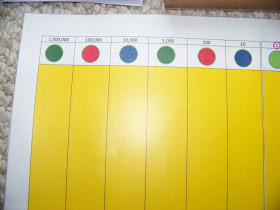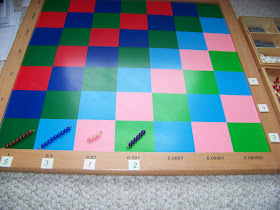After a child is familiar with the symbols representing decimals, he is ready for the decimal board. I knew my son would be quick to move from concrete to abstract so I hated to spend the money on the decimal board if it would only be used once or twice. So I made my own using Word and three pages, cut and then laminated together.
I did finally purchase the blocks and numbers to go with the board, knowing I could use them for my younger child later.
There were several introductory lessons for this board, but I was able to cover them all in just one lesson. I would imagine for a child with less experience you would need to plan on multiple lessons over the course of days or weeks.
The decimal board is 13 vertical yellow columns with represent the hierarchies. We use the typical Montessori colors (using blocks) to represent the amounts.
Formation and Reading of Quantities
The blocks are in the standard Montessori colors he is familiar with. He already knows that red is hundreds, blue is tens and green is units. But the new colors are pastel colors. They represent numbers LESS than one.
Once this is understood, I form a quantity on the board using the squares and I ask him to read it.
 |
| This board has the quantity: 2 hundreds, 4 tens, 1 unit, 3 tenths, 1 hundredth and 2 thousandths. |
Then I ask him to create quantities on the board. For example, I might say: “Give me two units, three tenths, three hundredths.” I start out calling them independently – instead of “two and thirty-three hundredths.”
Once I’m sure this is mastered, we go on to using the decimal numeral cards. The numeral cards tell us the decimal number’s “first name.”
0.1 = one tenth
0.01 = one hundredth
0.001 = one thousandth
3.27 = three units and twenty-seven hundredths
We build using this concept and then discuss the fact that whole numbers increase from the unit and decimals decrease from the unit. I put a little crown on the 1 (unit) on the board to represent it being the backbone of the whole system.
We also spent time talking about adding, subtracting and multiplying decimals using this board. There is quite a lot you can gain in terms of skills and understanding decimal concepts with this board. I highly recommend it for a child that needs a more concrete way to “see” how and why it all happens.
We didn’t spend much time on this board because of his current knowledge. If you’d like to have all of the lessons associated with the Decimal Board, you can purchase them for only $11.00 at this site:
The Decimal Checkerboard
The Decimal Checkerboard is similar to the Checkerboard used for multiplication of large numbers. Only this board is set up specifically for numbers greater AND smaller than one.
To the right of the unit and below the unit is always a lower hierarchy.
Whole numbers are still represented by dark green, dark blue and red.
Decimal numbers are represented by light blue, rose/pink, and light green.
First, I put labels all over the board to help my son see what each square represents.
 |
Then I asked the question: “If I were to put a bead (a bead representing 1) on every square of this board, what value would the board have?”
The Answer: 1,234,567.654.321
Next we worked on problems – a whole number as the multiplier, times a decimal number as the multiplicand.
 |
| The multiplicand is 5.312 - shown at the bottom of the board. It is the decimal number as shown above. |
 |
| The multiplier is 143. It is shown along the right-hand side of the board. |
Step 1: Place the numbers on the board for the multiplier and the multiplicand. (As shown above.)
Step 2: Begin the multiplication with the lowest hierarchy in the multiplier, placing the appropriate number of bead bars. When multiplying the unit, place the bars in the same squares on which the multiplicand cards are placed.
Then he turns over the unit multiplier label and beings the multiplication with the tens multiplier. He continues in a similar manner until all are complete.
 |
| When an amount is over 9, as in the example above, the tens place is shown in the next square to the left - which represents "carrying" the number over as you would do on paper. |
Step 4: Once complete, he moves all the bead bars down the diagonal to the lowest row on the board.
He makes any exchanges necessary.
Step 5: He reads the product and records it in his math notebook.
He loved the checkerboard – and performed problems nearly every day for a few weeks, just for the fun of it!





So happy to have found your post!! Thank you! I was trained how to use the checkerboard and then my lead teacher bought this one at a conference, but we didn't know exactly how to use it. Your post was so helpful. Thanks again!
ReplyDeleteAmber
Hi Amber,
DeleteI'm so glad to know it helped. I know how hard it was for me to find information and sort it all out - so I'm happy to share what I learn. Blessings!
Sheri
Thank you so much,nthis is very helpful. I am still a little confused, is the multiplicand 5.312? It looks like a decimal on the board, not 5,312. What would the answer be in your example! Thank you.
ReplyDeleteThank you for pointing that out. Yes, it was a typo on my part. It should be a decimal point and I have now corrected it. :-)
DeleteLove this post. I am writing a grant for our school--Pocatello Valley Montessori School-- and I borrowed one of the images from this page (one of the checkerboard images) to include in the grant proposal. Since it is your image, I'd like to get your permission to use it before I submit the grant. May I? It will help the proposal look more attractive.
ReplyDeleteThank you for asking, Leslie - Yes, you are welcome to use it! Best wishes on your grant writing!
Delete